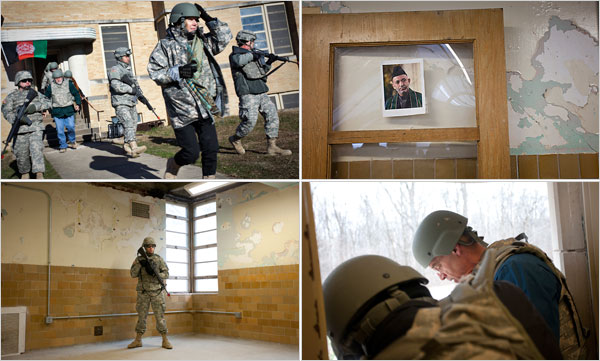Muscatatuck
 [Images: Inside Muscatatuck; photos by Mashid Mohadjerin for The New York Times].
[Images: Inside Muscatatuck; photos by Mashid Mohadjerin for The New York Times].Before shipping out to Afghanistan, the U.S. Army and members of the Indiana National Guard have been training inside a simulated Afghan village—using what the New York Times describes as a "vaguely foreboding institution that once served as a farm colony for 'feeble-minded' boys, and later was a state mental hospital."
- The Army and the Indiana National Guard have turned the windswept complex, known as Muscatatuck, into a simulacrum of a war-torn Afghan city, with a courthouse, a jail and a graffiti-smeared marketplace. While the table-flat farmland around here hardly evokes the Hindu Kush, this is where the government trains Americans who are part of the most ambitious civilian campaign the United States has mounted in a foreign country in generations—a “civilian surge” intended to improve the lives of Afghans.
This is, of course, only the most recent example of these sorts of facilities to receive media attention; it is but one part of the massive network of militarized simulations that have been built throughout the United States since 9/11 (and these facilities, of course, are themselves nothing new nor are they unique to the United States: there are historical precedents dating back millennia, as any competent military since the dawn of invasion has simulated its spatial tactics in advance). One such facility even hired actor Carl Weathers, of Apollo Creed fame, to serve as an "acting coach" for the simulated insurgents.
But the passage of U.S. Army trainees through a repurposed mental hospital—in fact, "a farm colony for 'feeble-minded' boys"—with the implication that this will help to prepare them for the violence of foreign wars, is extraordinary.





Comments are moderated.
If it's not spam, it will appear here shortly!
I had to re-format a link in a comment from anonymous:
-------------------------------------
The fact that Tobias Funke (whom Carl Weathers coaches) plays an "insurgent" (George Sr) on scandal makers makes this too surreal.
Do you like ham?
No.
[pause]
I love it.
This reminds me of a facility suposedly operated on the windward side of Oahu some time during the Vietnam war. The military is rumored to have built a replica prison camp back in the mountains complete with vietnamese speaking guards. It is said that special forces soldiers were sedated in the night and taken from their barracks to the secret location without prior knowledge. Upon awaking they would find themselves in a prison camp where they would be interogated and treated as prisoners for several weeks. The goal was to see how our best trained troops would hold up to the interogation process. They also suposedly dug a tunnel complex to simulate the tunnels of Cu Chi in order to teach soldiers how to carry out missions in this environment.
Post a Comment